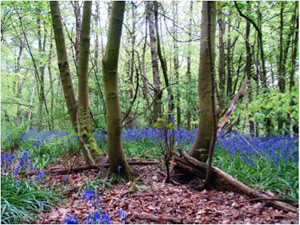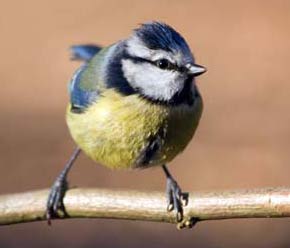Birds in woodlands

Watching birds in woodland can be very rewarding but, at the same time, very frustrating! The old adage "can't see the wood for the trees" certainly comes in to play. You can be surrounded by bird song yet not see a single one. Birdwatchers then have to rely on the one piece of equipment they forget all about – their ears! Knowing your bird songs and calls is vital as trying to track a bird using binoculars as it flits though thick cover can be almost impossible. Knowing what to expect is also useful. While there are some birds like Chaffinch that occur in all woodlands, there are some that are more common in say deciduous woods and others like the Goldcrest and Coal Tit that prefer coniferous woods. Once you have assimilated all that you can walk through a wood without binoculars, and even with your eyes shut, and still get a reasonable species list!
What birds you see will also depend on the time of year. Winter can be a lean time. You can walk through a wood one day and see nothing at all and on another day – loads of birds. In winter birds such as tits, Goldcrest, Treecreeper etc tend to move around a wood in mixed flocks so unless you come across the flock you see nothing! Within these flocks you find the various species feeding on slightly different foods and at different heights. Blue Tits for instance can feed along more slender branches than heavier Great Tits. This all helps to avoid competition.
Blue Tits for instance can feed along more slender branches than heavier Great Tits. This all helps to avoid competition.
Come spring birds start to set up territories and become more vocal and of course we start to get the summer migrants. Which species you find will depend on the type of woodland. Oak woods will attract Redstarts, if there is a stream running through you might find Pied Flycatchers; if there are clearings then Tree Pipits might appear. The understorey is also important. Lots of scrub will attract Wood Warbler, Blackcap and Garden Warbler. It can be fascinating to survey the different types of wood and look at the species occurring in each. Eventually it is possible to look at a wood and predict what species you will find!
In late summer the woods go quiet as birds have nested, the young have moved off and the adults become secretive as they moult. By late autumn, most of the migrants have left and we start to get roving bands of tits and finches as they search out the fruits of the season. The first winter migrants – Fieldfares and Redwings arrive. They visit the woods for berries but also to roost, sometimes in flocks numbering hundreds or more.
Yes, woodlands are great places to watch and listen to birds. To hear a Mistle Thrush singing on a still, crisp spring morning or a Redstart warbling from an Oak in summer or watching a tit flock in winter in the expectation of something rarer like a Firecrest with them makes woodland hard to beat.
David W. Emley, author of 'Bird Life of Keele University
http://www.keele.ac.uk/media/keeleuniversity/arboretum/downloads/birdlife%20of%20keele.pdf
Comments are closed for this post.
Discussion
A fascinating account of woodland ornithology. Once you’ve let your ears behold a woodland dawn chorus, there will be a longing to return, year after year.

I agree about the woodland dawn chorus. It can be a bit annoying if woken up by it at first, but listening to the dawn chorus is a truly amazing experience!
Sharon Newall
19 March, 2013